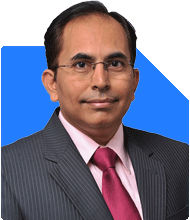26-year-old seeking expert advice on growing 30 lakhs to 1 crore in 3 years with stocks and mutual funds
Ramalingam Kalirajan |10283 Answers |Ask -Follow
Mutual Funds, Financial Planning Expert - Answered on Oct 22, 2024
He has an MBA in finance from the University of Madras and is a certified financial planner.
He is the director and chief financial planner at Holistic Investment, a Chennai-based firm that offers financial planning and wealth management advice.... more

Need expert advise on converting my 30 lacks FD to 1Cr through stocks and Mutual funds in max 3 years
Let’s explore a more achievable, disciplined approach to wealth creation, keeping realistic expectations in mind.
No Shortcuts to Wealth Creation
Avoid Quick-Rich Schemes: Many investors are drawn to schemes that promise rapid wealth creation, but these are often high-risk and prone to failure. Building wealth is a long-term process, requiring patience and discipline.
50% Annual Growth Is Unrealistic: Achieving a 50% annual growth is not only improbable but also highly risky. Markets can be volatile, and investments that aim for such high returns are often speculative in nature.
Focus on Sustainable Growth: It’s more realistic to aim for stable, sustainable growth. Over a three-year horizon, expect returns in the range of 6-8% annually, which is more aligned with the historical performance of a well-balanced portfolio.
Realistic Return Expectations
For Short-Term (3 Years): Over a short-term period like three years, expecting returns in the range of 6-8% is more reasonable. This allows for capital appreciation while minimizing risk. A combination of balanced funds, conservative equity funds, and debt instruments will help you achieve these returns with lower volatility.
For Long-Term (7+ Years): If you extend your investment horizon to seven years or more, you can realistically aim for 10-12% annual returns. Long-term equity investments tend to outperform other asset classes, and the power of compounding works in your favor over time.
Stock Investments
Direct Stocks Require Caution: Investing in individual stocks can generate high returns, but they also carry high risk, especially in the short term. Focus on blue-chip stocks or fundamentally strong companies that can withstand market fluctuations. However, even with these stocks, 50% annual returns are unlikely over a three-year period.
Avoid Speculative Stocks: Speculative stocks may promise quick gains, but they often lead to significant losses. It’s essential to avoid the temptation of “get-rich-quick” stocks. Instead, focus on quality companies with consistent growth and a proven track record.
Mutual Fund Investments
Balanced Approach with Mutual Funds: For the short term, consider a mix of equity and debt mutual funds. Equity funds will give you exposure to growth, while debt funds will provide stability. Aggressive equity funds may be tempting, but in a three-year window, their performance can be highly volatile.
Active Funds Over Index Funds: Actively managed funds have the potential to outperform the market, especially in a short-term horizon. Unlike index funds, which simply track the market, actively managed funds aim to beat the market, giving you a better chance of achieving moderate growth.
Debt Funds for Stability: In a three-year horizon, debt mutual funds can offer a more predictable return, helping to stabilize your portfolio. Though they won't provide the high returns that equities might, they serve as a safety net against market downturns.
Avoid Unrealistic Expectations
Stay Away from High-Risk Strategies: Strategies that promise extraordinary returns in a short time frame often carry a high risk of loss. Stick to a plan that balances growth with capital protection. The risk of losing your initial capital is too high when chasing high returns.
Gradual Wealth Creation: There is no magic formula for quick wealth creation. It’s about consistent, disciplined investing over time. A well-planned, diversified portfolio with moderate growth expectations is your best bet for steady capital appreciation.
Certified Financial Planner (CFP) for Professional Guidance
Avoid Shortcuts with Professional Help: Engaging a Certified Financial Planner (CFP) can help you avoid the common pitfalls of chasing high returns in a short time frame. They will help you structure your investments to align with realistic goals and timelines.
Long-Term Focus: A CFP will guide you in building a long-term plan, focusing on sustainable growth rather than speculative gains. Over time, they can help you optimize your portfolio for better returns while minimizing risks.
Disadvantages of Direct Funds
Lack of Expertise: Direct funds may save on fees, but without professional management, you may miss out on key opportunities. A CFP can actively manage your investments, adjusting them based on market conditions and your goals.
No Risk Management: Investing directly without professional advice increases the risk of poor decisions, particularly in volatile markets. With a CFP, your investments are monitored, and risk management strategies are implemented as needed.
Portfolio Construction for Realistic Growth
50% in Conservative Equity Funds: For the short term, consider allocating 50% of your Rs 30 lakh into conservative equity mutual funds. These funds focus on stable, large-cap companies that offer moderate growth with lower volatility compared to mid-cap or small-cap funds.
30% in Debt Funds: Allocate 30% to debt mutual funds to provide stability. Debt funds will generate a steady return, helping to protect your portfolio from market downturns.
20% in Balanced Funds: Invest 20% in balanced or hybrid funds that combine equity and debt. These funds adjust the balance between risk and reward automatically, based on market conditions, providing a cushion against potential losses.
Importance of Risk Management
Avoid High-Risk Investments: Avoid investing in high-risk sectors or speculative stocks that promise quick returns. The potential for loss far outweighs the possibility of high gains, especially in the short term.
Rebalance Regularly: Even with a well-structured portfolio, market conditions can change. Rebalance your portfolio every six months to ensure it aligns with your risk tolerance and financial goals.
Protect Your Capital: Your primary goal should be to protect your capital while aiming for reasonable growth. A balanced portfolio helps achieve this by reducing exposure to high-risk investments.
Taxation on Gains
Equity and Debt Funds: Equity mutual funds and stocks are subject to long-term capital gains (LTCG) tax of 12.5% for gains above Rs 1.25 lakh. Short-term capital gains (STCG) are taxed at 20%. Debt funds, on the other hand, are taxed as per your income tax slab.
Tax-Efficient Withdrawals: Staggering your withdrawals can help minimize the tax impact. A Certified Financial Planner (CFP) can assist you in planning a tax-efficient exit strategy to maximize your net returns.
Final Insights
Growing Rs 30 lakh to Rs 1 crore in just three years is highly unrealistic. Aiming for such high returns involves extreme risk, which could lead to significant losses.
For a short-term investment horizon of three years, expect returns of 6-8% annually. Focus on a balanced portfolio that includes equity, debt, and balanced funds.
Avoid high-risk, quick-rich schemes and speculative investments. Sustainable wealth creation is a long-term process that requires patience and discipline.
A Certified Financial Planner (CFP) can help you create a diversified, risk-managed portfolio tailored to your goals and risk tolerance.
For long-term horizons of 7+ years, you can reasonably expect annual returns in the range of 10-12%. This is achievable with a well-diversified portfolio of equities, bonds, and other growth assets.
Best Regards,
K. Ramalingam, MBA, CFP,
Chief Financial Planner
www.holisticinvestment.in
https://www.youtube.com/@HolisticInvestment
You may like to see similar questions and answers below
Omkeshwar Singh | Answer |Ask -Follow
Head, Rank MF - Answered on Jul 19, 2022
Omkeshwar Singh | Answer |Ask -Follow
Head, Rank MF - Answered on Oct 13, 2022
Ramalingam Kalirajan |10283 Answers |Ask -Follow
Mutual Funds, Financial Planning Expert - Answered on May 16, 2024
Milind Vadjikar | Answer |Ask -Follow
Insurance, Stocks, MF, PF Expert - Answered on Oct 21, 2024
Janak Patel |65 Answers |Ask -Follow
MF, PF Expert - Answered on Jan 16, 2025
Nayagam P P |10376 Answers |Ask -Follow
Career Counsellor - Answered on Aug 18, 2025
Nayagam P P |10376 Answers |Ask -Follow
Career Counsellor - Answered on Aug 18, 2025
Nayagam P P |10376 Answers |Ask -Follow
Career Counsellor - Answered on Aug 18, 2025
Nayagam P P |10376 Answers |Ask -Follow
Career Counsellor - Answered on Aug 18, 2025
Nayagam P P |10376 Answers |Ask -Follow
Career Counsellor - Answered on Aug 18, 2025
Nayagam P P |10376 Answers |Ask -Follow
Career Counsellor - Answered on Aug 18, 2025
Nayagam P P |10376 Answers |Ask -Follow
Career Counsellor - Answered on Aug 18, 2025
Dr Nagarajan J S K |2308 Answers |Ask -Follow
NEET, Medical, Pharmacy Careers - Answered on Aug 18, 2025
Dr Nagarajan J S K |2308 Answers |Ask -Follow
NEET, Medical, Pharmacy Careers - Answered on Aug 18, 2025
Radheshyam Zanwar |6426 Answers |Ask -Follow
MHT-CET, IIT-JEE, NEET-UG Expert - Answered on Aug 18, 2025























